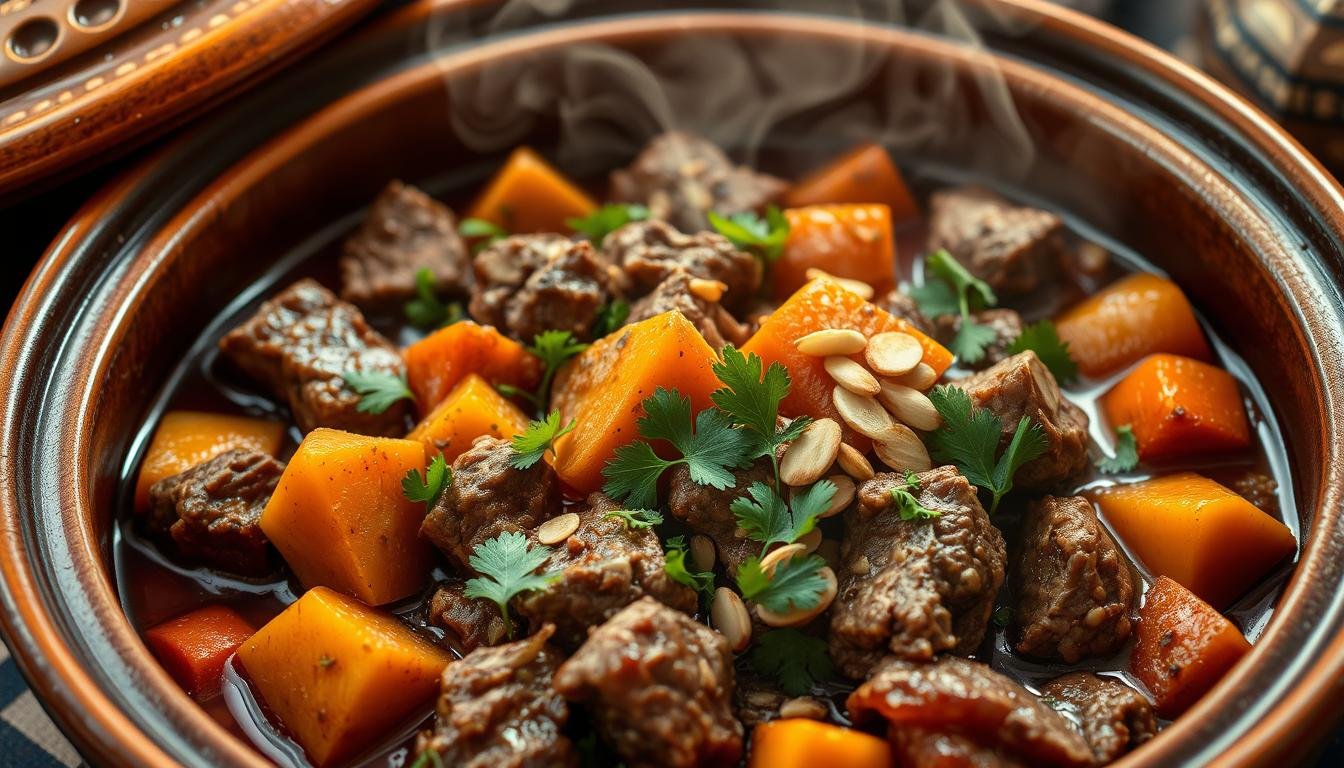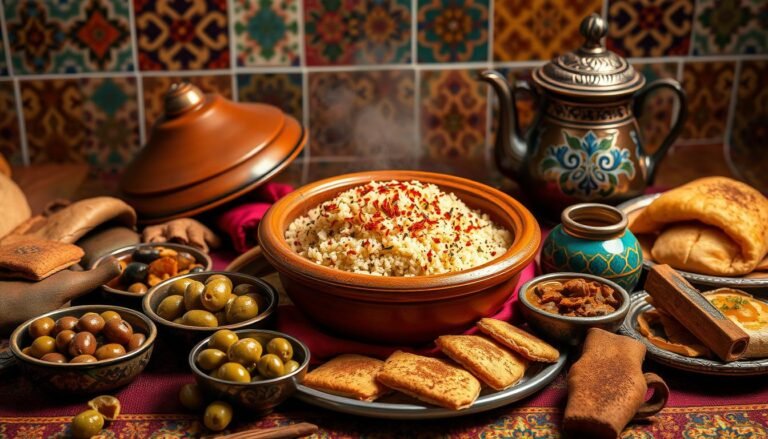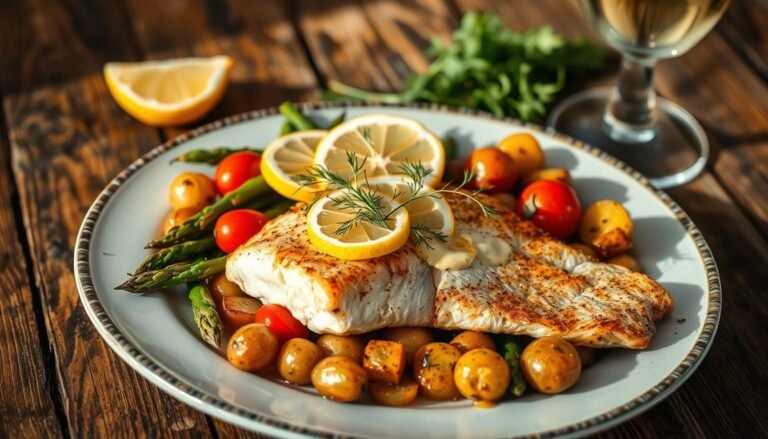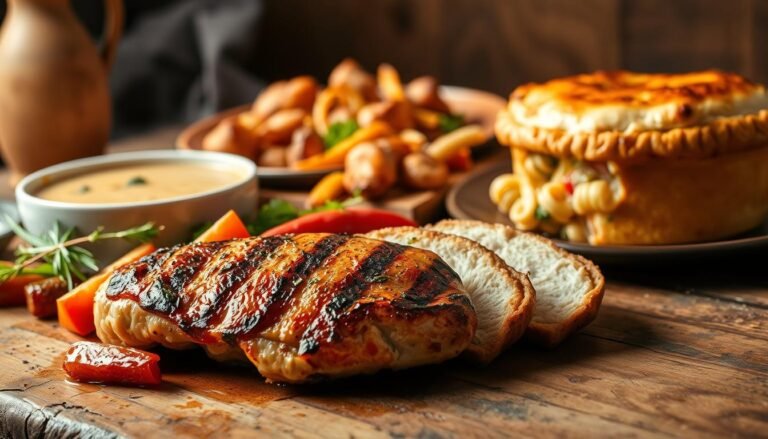Explore the Delights of Moroccan Tajine Cuisine
Moroccan Tajine: The ancient art of cooking with a tagine has been a cornerstone of North African cuisine for centuries. This traditional method involves slow-cooking a variety of ingredients in a distinctive clay pot, also called a tagine.
The result is a rich, flavorful dish that showcases the perfect blend of spices and tender ingredients. Whether you’re a seasoned cook or just starting to explore the world of cooking, the tagine offers a delicious adventure into one of the world’s most distinctive food traditions.
With its unique conical lid, the pot creates a natural condensation cycle that continuously bastes the recipe during cooking, resulting in exceptionally tender and flavorful outcomes. Discover the rich heritage and authentic recipes behind this beloved culinary tradition.
The Rich Heritage of Moroccan Tajine
The Tajine is more than just a dish; it’s a reflection of Morocco’s cultural heritage. With a history that spans centuries, Tajine cooking has evolved into a sophisticated culinary art form.
Origins and Cultural Significance
Tajine cooking has its roots in traditional Berber and Ottoman cuisines. In the traditional Berber implementation, a fire is made in a hole in the ground, and the clay pot is nestled inside, buried, and left for many hours. This slow cooking process results in tender meat and a hearty stew.
The cultural significance of Tajine extends beyond its flavor profile; it represents the hospitality and warmth of Moroccan culture. The traditional cooking methods and the patience required to prepare a Tajine reflect the unhurried pace of Moroccan culinary culture.
Traditional Cooking Methods
Authentic Tajine cooking takes place over low heat, often using charcoal or wood embers. The pot, with its distinctive conical lid, plays a crucial role in the cooking process, allowing for the slow development of flavors over several hours of gentle simmering.
- Layering ingredients in a specific order ensures proper cooking of all components.
- Minimal stirring or disruption allows for natural steam circulation within the vessel.
- The conical lid collects steam and redirects condensation back into the stew, creating a self-basting environment.
While modern adaptations may use stovetops, ovens, or even slow cookers, traditional methods impart a unique, earthy flavor that is characteristic of Tajine cuisine.
Understanding the Tajine Cooking Vessel
For those exploring Moroccan cuisine, understanding the Tajine cooking vessel is essential for authentic cooking. The Tajine is more than just a pot; it’s a cooking technique and a cultural symbol that has been passed down through generations.
The Unique Design and Function
The Tajine’s distinctive design features a round base and a conical lid, which allows for the condensation of steam and the return of moisture to the dish, ensuring that the food is cooked evenly and remains moist. This unique design is crucial for the slow cooking process that Tajine recipes often require.
Clay vs. Ceramic Tajines
When it comes to choosing a Tajine, cooks often debate between traditional clay and modern ceramic options. The choice between these materials affects not only the cooking experience but also the flavor and authenticity of the dishes prepared.
| Material | Characteristics | Cooking Experience |
|---|---|---|
| Clay | Traditional, unglazed, imparts earthy flavor | Requires careful handling, gradual heat increase |
| Ceramic | Modern, often glazed, dishwasher-safe | Versatile, works on stovetops, in ovens, and on grills |
While traditional clay Tajines offer an authentic experience and unique flavors, ceramic Tajines provide convenience and durability. For serious Moroccan cooking enthusiasts, having both types can offer flexibility: clay for traditional dishes and ceramic for everyday cooking. It’s also worth noting that many Moroccan Tajines are safe to use in the oven, but it’s recommended to check the manufacturer’s directions.
The heat distribution differs between clay and ceramic Tajines, with clay heating slowly and retaining heat longer, and ceramic responding more quickly to temperature changes. This difference can affect the final outcome of the dish, making the choice of Tajine a crucial aspect of cooking with this traditional Moroccan pot.
Essential Spices in Moroccan Tajine
At the heart of Moroccan Tajine lies a diverse array of essential spices that contribute to its distinctive flavor profile. The use of spices in Tajine cooking is not just about adding heat or flavor; it’s an art that has been refined over centuries.
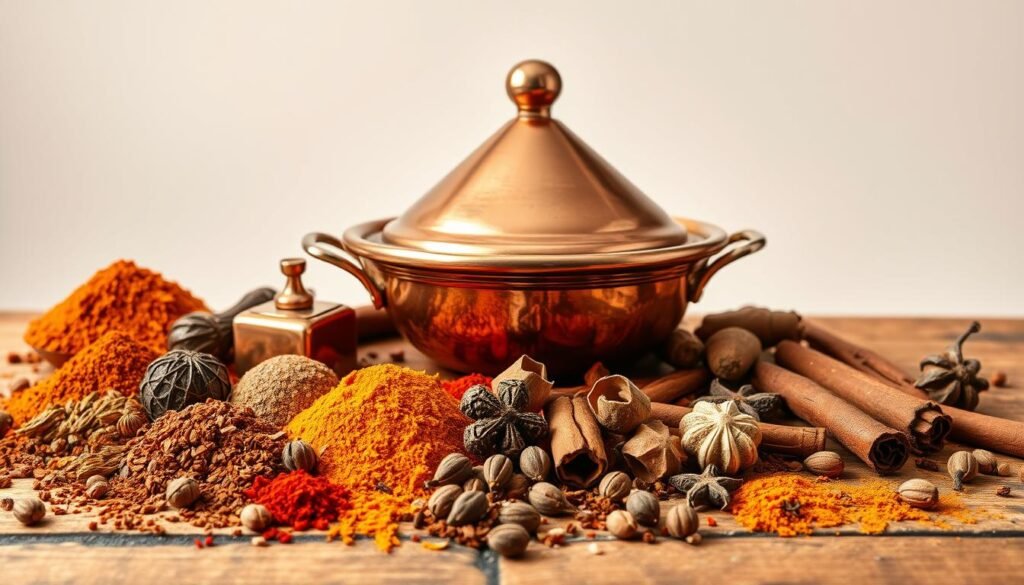
Ras El Hanout: The Signature Spice Blend
Ras El Hanout, which translates to “head of the shop,” is a complex blend of spices that can include over 30 different ingredients, such as cinnamon, turmeric, coriander, and ginger. This signature spice blend is a cornerstone of Moroccan cuisine and is used to add depth and warmth to Tajine dishes. As one renowned chef notes, “Ras El Hanout is the essence of Moroccan cooking, a blend that encapsulates the country’s rich culinary heritage.”
Other Key Spices and Aromatics
Beyond Ras El Hanout, individual spices play crucial roles in Moroccan Tajine cooking. Garlic, onion, and ginger form the aromatic flavor base, typically sautéed in hot oil at the beginning of the cooking process. Other key spices include cumin, turmeric, and paprika, which add warmth and complexity to the dishes. The use of preserved lemon adds a unique tanginess, while saffron contributes its distinctive flavor and golden color in special preparations. The balance of salt is also crucial, as it enhances the flavors drawn out during the long cooking time.
Fresh herbs like cilantro and flat-leaf parsley are used both during cooking and as garnishes, adding brightness and color to the completed dish. The combination of these spices and aromatics creates the characteristic sweet-savory balance that defines Moroccan Tajine cuisine.
Classic Lamb Tajine Recipe
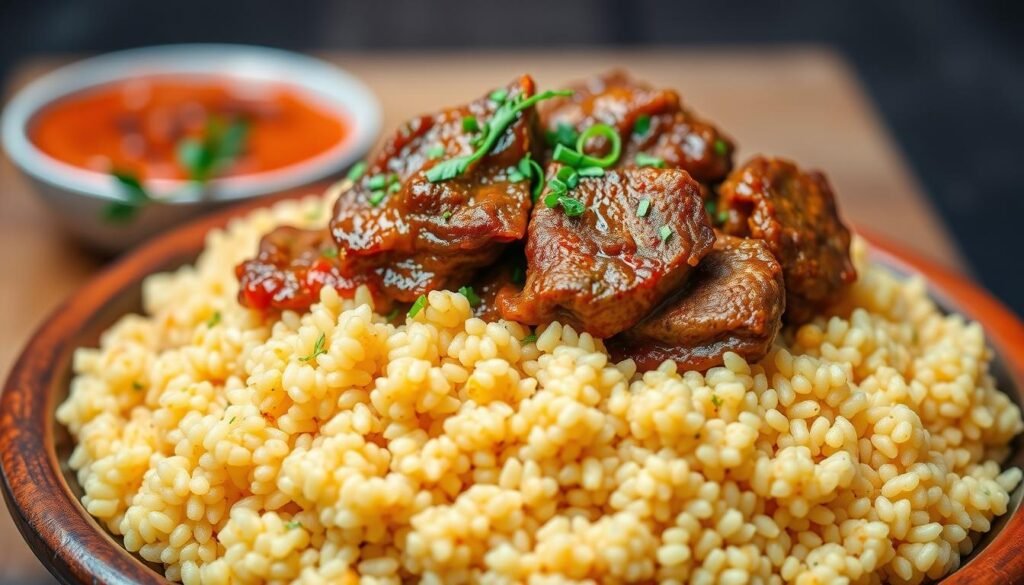
Experience the rich flavors of Morocco with our Classic Lamb Tajine Recipe. This traditional dish is a staple of Moroccan cuisine, known for its tender lamb and rich, aromatic sauce.
Ingredients and Preparation
To prepare this authentic Moroccan recipe, you’ll need lamb shoulder or neck, olive oil, onions, garlic, ginger, and a blend of spices including cumin, coriander, and cinnamon. Don’t forget a cup of chicken or beef broth and a squeeze of fresh lemon juice. The key to a great tajine is in the slow cooking process, which allows the flavors to meld together and the lamb to become tender.
Cooking Process and Techniques
Cooking a lamb tajine involves layering the ingredients in a traditional clay or ceramic tajine pot, which is designed to distribute heat evenly. Start by browning the lamb in olive oil, then add sliced onions and minced garlic until they’re softened. Add the spice blend, broth, and lemon juice, and let it simmer on low heat for about 2 hours, or until the lamb is tender and the sauce has thickened.
Serving Suggestions
Serve the lamb tajine over a bed of fluffy couscous, garnished with toasted almonds, freshly chopped cilantro, and a sprinkle of lemon zest. For an authentic experience, present the tajine in its cooking vessel at the center of the table. Consider serving with warm Moroccan bread (khobz) for scooping up the tender meat and sauce, and accompany with small side dishes like marinated olives or a fresh salad with citrus dressing.
The rich, flavorful sauce of the lamb tajine is perfectly complemented by the light, fluffy texture of couscous. This classic combination is a staple of Moroccan cuisine, and for good reason – the couscous acts as a canvas, soaking up the delicious sauce and allowing you to enjoy every last bite.
Moroccan Tajine with Chicken and Preserved Lemons
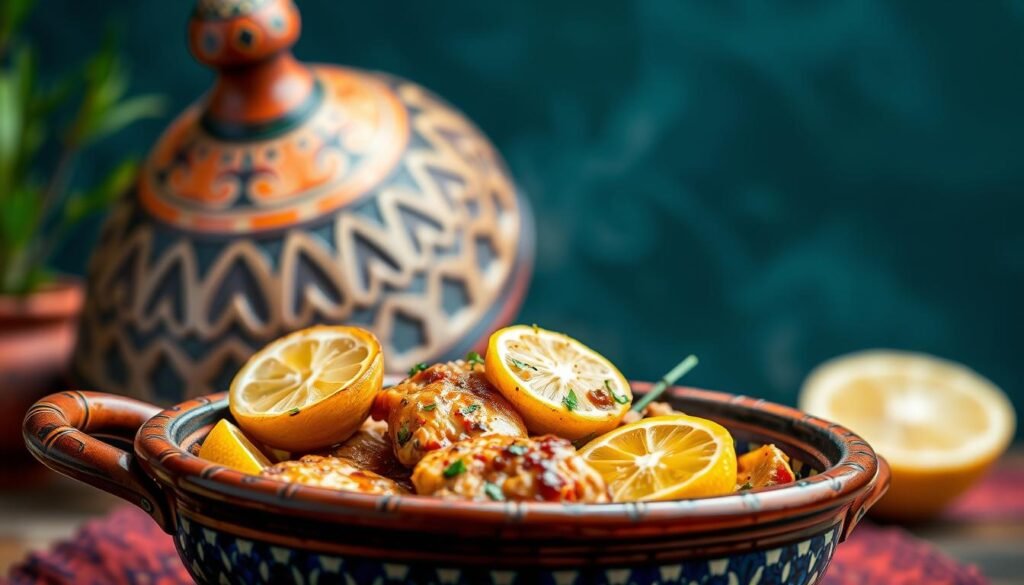
The combination of chicken, preserved lemons, and spices in a traditional Tajine pot creates a truly unforgettable meal. This classic Moroccan dish is known for its rich flavors and aromas, making it a staple in many cuisines around the world.
Ingredients and Preparation
To make this delicious Chicken Tajine, you’ll need ingredients such as chicken thighs, preserved lemons, green olives, coriander, and a blend of Moroccan spices. Begin by preparing your ingredients: chop the preserved lemons, mince the fresh coriander, and pit the green olives.
Next, layer the chicken, spices, preserved lemons, and olives in the Tajine pot. The sauce will be a key component, so be sure to include enough liquid to cover the ingredients.
Step-by-Step Cooking Instructions
Cooking the Tajine is a straightforward process. Start by heating the pot over medium heat, then transfer it to a preheated oven. The slow cooking process allows the flavors to meld together, creating a rich and savory sauce.
Once the chicken is fully cooked, you have the option to broil it for a crispy skin. Remove the Tajine from the oven, set the temperature to broil, and carefully move the chicken to a baking sheet. Broil for 5 minutes or until the skin is golden brown.
Traditional Garnishes
Traditional garnishes for Chicken Tajine include fresh cilantro and parsley, which add bright color and herbaceous notes. The preserved lemon slices, now mellow in flavor, are typically arranged on top of the chicken. Green olives provide a briny contrast, balancing the dish’s flavors.
For an elegant presentation, arrange the chicken pieces in the center of the Tajine, with preserved lemon slices and olives visible. Sprinkle fresh herbs around the perimeter, and serve with couscous or fresh bread.
Vegetable Tajine for Plant-Based Diets
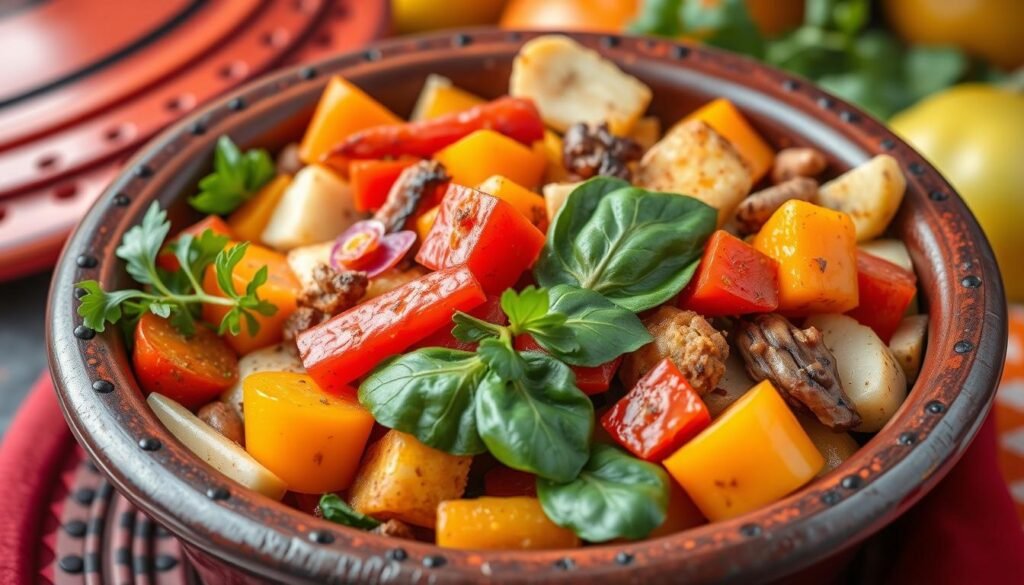
The rich flavors of Moroccan cuisine are perfectly captured in a vegetable tajine, making it an ideal dish for plant-based diets. Vegetable tajine cooking follows similar principles to its meat-based counterparts but requires careful attention to the varying cooking times of different vegetables to prevent some from becoming mushy while others remain undercooked.
Key Ingredients and Variations
The beauty of vegetable tajine lies in its versatility. You can use a variety of vegetables such as carrots, zucchini, bell peppers, and eggplant. The layering technique is crucial—placing longer-cooking root vegetables at the bottom near the heat source, with quicker-cooking ingredients arranged toward the top. This method ensures that all the vegetables are cooked to perfection.
Cooking Method
Cooking vegetable tajine in the oven is highly recommended as it provides gentle, surrounding heat that allows vegetables to cook evenly without requiring frequent stirring. While a traditional clay tagine is ideal, vegetable tajines adapt well to Dutch ovens or heavy-bottomed pots with tight-fitting lids when cooked in a conventional oven. This method helps to intensify the natural sweetness of the vegetables and creates a complex flavor profile that pairs beautifully with warming spices.
Unlike meat tajines, vegetable versions can often be completed in 45-60 minutes. However, longer cooking times can develop deeper flavors in the sauce. It’s also important to maintain slightly more liquid during cooking than you would for meat versions, as vegetables don’t release as much moisture during the process.
Alternative Cooking Methods Without a Tajine
While traditional Moroccan Tajine cooking is best done in a clay or ceramic Tajine pot, there are alternative methods for those without access to this specialized cookware. If you’re looking to recreate the rich flavors of Tajine cuisine, you can use modern cooking techniques and alternative cookware.
Using a Dutch Oven
A Dutch Oven is an excellent alternative for cooking Tajine-inspired dishes. It allows for even heat distribution and can be used at low temperatures for a long cooking time, similar to traditional Tajine cooking. To achieve the best flavor, brown your meat and sauté your aromatics before slow cooking in the Dutch Oven. This method enhances the flavor and tenderizes the meat, much like traditional Tajine recipes.
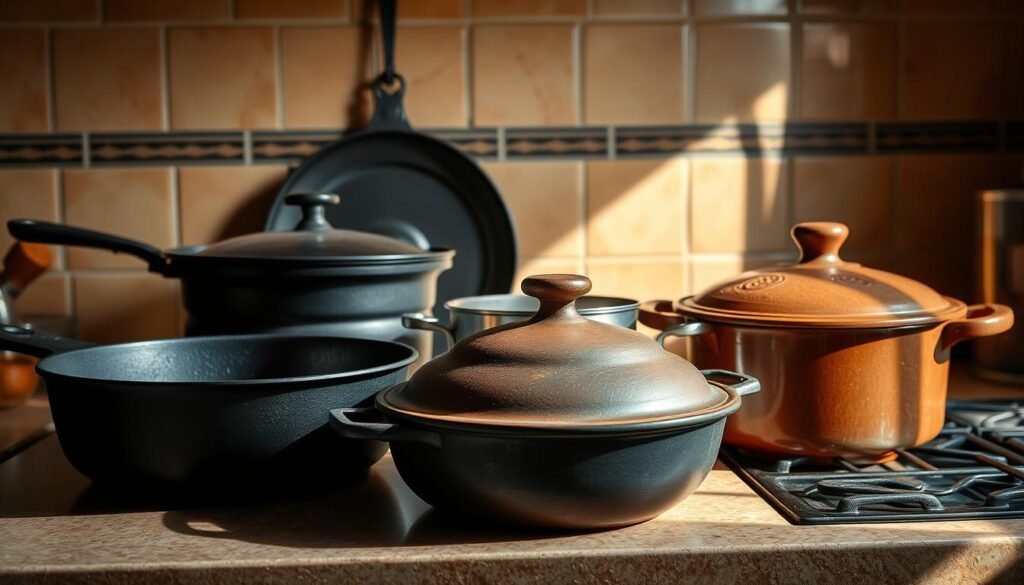
Slow Cooker and Pressure Cooker Adaptations
For convenience, you can use a slow cooker or pressure cooker to make Tajine-inspired dishes. When using a slow cooker, reduce the liquid by about 25-30% since there’s minimal evaporation during cooking time. Cook on low for 6-8 hours or high for 3-4 hours to achieve tender results. For a pressure cooker, adjust the spices as needed and cook for dramatically reduced time, typically 35-45 minutes for a lamb Tajine. After cooking, you can reduce the sauce separately by simmering it until it reaches the desired consistency.
| Cooking Method | Cooking Time | Liquid Adjustment |
|---|---|---|
| Dutch Oven | 2-3 hours | Minimal |
| Slow Cooker | 6-8 hours (low), 3-4 hours (high) | Reduce by 25-30% |
| Pressure Cooker | 35-45 minutes | Adjust as needed |
Conclusion: Embracing the Flavors of Morocco at Home
Embracing Moroccan Tajine cooking at home opens up a world of possibilities for creating delicious, memorable meals. The rich flavors and aromas of a traditional chicken tagine or lamb dish, slow-cooked to perfection with preserved lemons and a blend of spices, can transport your family and friends to the heart of North Africa.
The beauty of tagine cooking lies in its accessibility and versatility. Whether you’re using a traditional clay tagine or adapting recipes for modern appliances like a Dutch oven or slow cooker, the fundamental techniques remain the same. This makes it easy to experiment with different recipes and ingredients, from classic lamb with dried fruits to chicken tagine with preserved lemon.
As you explore the world of Moroccan Tajine, you’ll discover a culinary tradition that values slow cooking and communal sharing. So, take the first step, and let the flavors of Morocco enrich your cooking repertoire.

